How Much Does a Home Wind Turbine Cost?
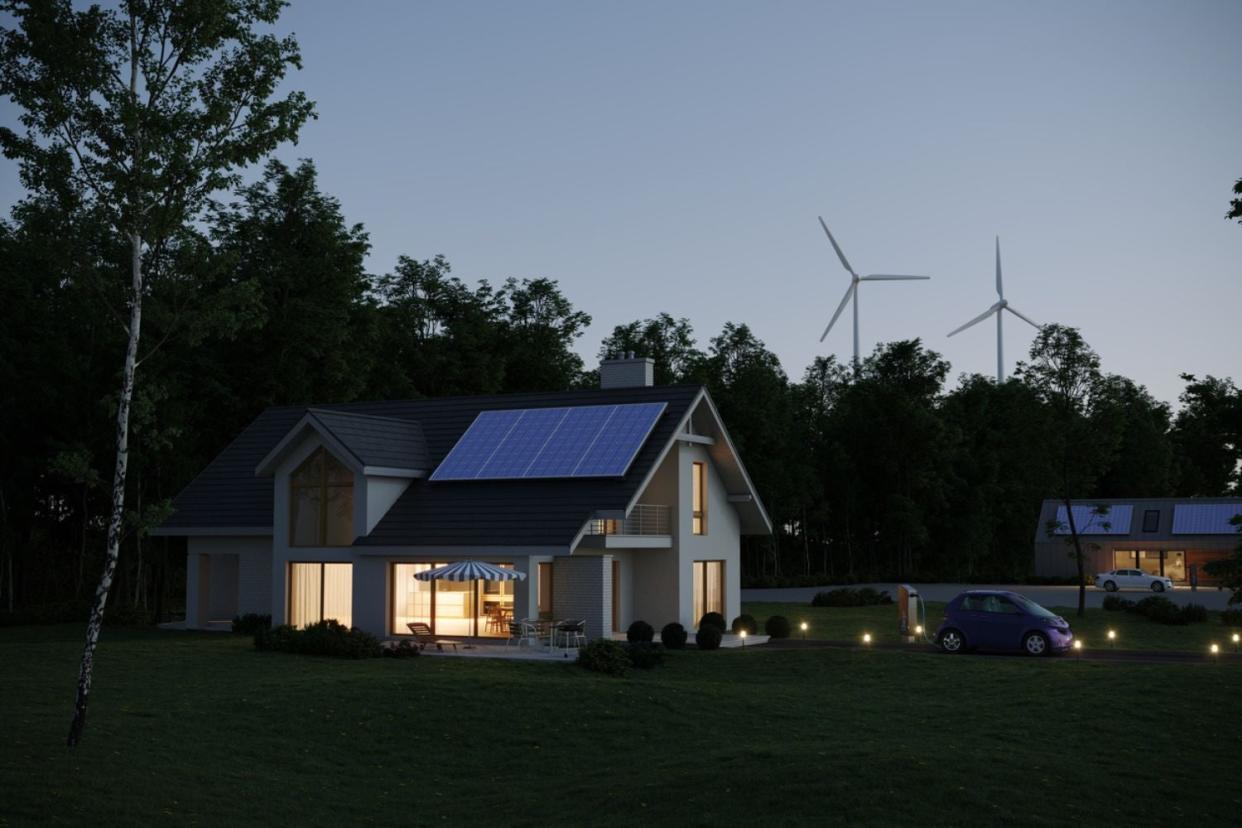
Highlights
The typical cost to install a home wind turbine ranges between $300 and $75,000.
Some of the factors that affect the total cost include the turbine’s type, size, and capacity; the wind speed requirements; the installation location; the cost of labor; ongoing maintenance costs; and available tax credits.
There are several benefits to installing a wind turbine at home, including decreased energy bills, increased home value, high efficiency, and clean energy.
Homeowners may be able to install a small wind turbine themselves; however, hiring a pro will result in a safe and compliant installation.
Harnessing wind energy for residential use has become increasingly popular as people seek cleaner and more sustainable power sources. But just how much does it cost to install wind turbines on residential properties? The typical cost range for a home wind turbine installation can vary significantly, ranging from as little as $300 to as much as $75,000.
The wide range is due to cost factors such as the size and type of turbine, wind speed requirements, installation location, and site preparation. Each of these can vary significantly from one property (or part of the country) to another. Homeowners interested in using renewable energy on their property can learn more about what goes into estimating a home wind turbine cost, the benefits that come along with having a clean energy source at home, and ways to save money on installation.
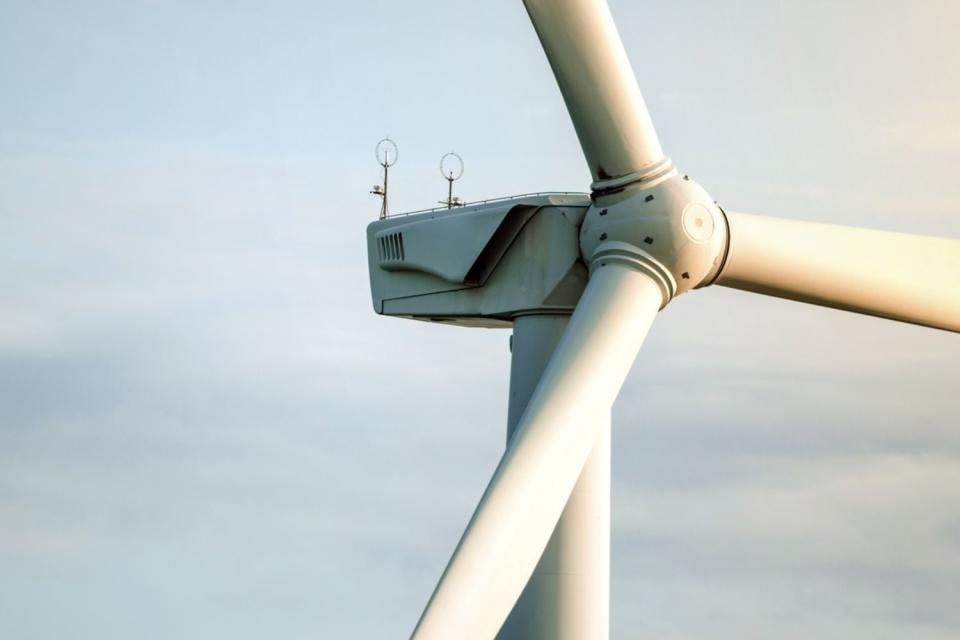
Photo: istockphoto.com
Factors in Calculating Home Wind Turbine Cost
Determining an accurate budget to install a wind turbine for home use will require homeowners to review several factors in addition to speaking with a professional installation company. For example, turbine size, installation location, and ongoing maintenance fees can all influence installation and operating costs. While national average costs can serve as a useful benchmark, understanding local variations for labor and material costs can also help a homeowner properly budget for a wind turbine.
Turbine Type, Size, and Capacity
Turbine type, size, and capacity play important roles in determining both the effectiveness and cost of wind energy systems. There are two main types of wind turbines for homes: roof-mounted and freestanding. Roof-mounted designs are the most cost-effective option, whereas freestanding options are the more expensive choice. However, the latter can generate greater amounts of electricity than a roof-mounted design.
The size of a wind turbine refers to blade length and tower height. A larger turbine will likely have higher up-front material and installation costs than a small wind turbine. Similarly, the capacity of a turbine, or the maximum amount of electricity the unit can generate under ideal conditions, influences pricing. Homeowners can expect to pay more for higher-capacity turbines.
Wind Speed Requirements
The wind speed requirements for a home turbine correlates to the unit’s effectiveness, type of unit needed, and overall costs. Wind speed directly influences how much energy a turbine can generate and, in turn, how much potential return on investment a homeowner can expect. Homeowners can calculate their capacity factor (the measure of a turbine’s efficiency) with this basic formula:
Capacity factor = (average wind speed) / (rated wind speed)
If the average wind speed is 6 meters per second (m/s), and the small wind turbine has a rated wind speed of 30 m/s, then the capacity factor would be 0.2 or 20 percent.
Capacity factor = (6 m/s) / (30 m/s) = 0.20
In this example, the turbine could generate electricity at 20 percent of its capacity, on average, which is more than the 17 percent average capacity as noted in the 2018 report by the U.S. Department of Energy.
Homeowners can then calculate the number of kilowatt (kW) hours that can be produced by a small wind turbine if the wind blows frequently.
Kilowatt hours per year = (number of hours in a year) x (unit’s power rating) x (capacity factor)
A typical home in a windy area needs a 10 or 15 kW turbine to provide sufficient power. This number can be multiplied by the number of hours in a year and the capacity factor.
8,760 x 15 x 0.20 = 26,280 kW hours per year
Understanding the rated wind speed and how it affects the capacity factor helps homeowners assess the suitability of a wind turbine for their location. If the average wind speed in an area is significantly lower than a turbine’s rated wind speed, then the turbine may not operate efficiently, resulting in lower energy production and potentially a poor return on investment. The American Wind Energy Association (AWEA) notes that homeowners usually pay an installation cost of $2,000 to $5,000 per kilowatt of the unit’s power capacity. This means it could cost between $30,000 and $75,000 to install a 15 kW wind turbine.
Generally speaking, turbines with higher-rated wind speeds may cost more to install due to their enhanced performance capabilities and advanced technology. However, they could also generate more energy and be more efficient in the long run.
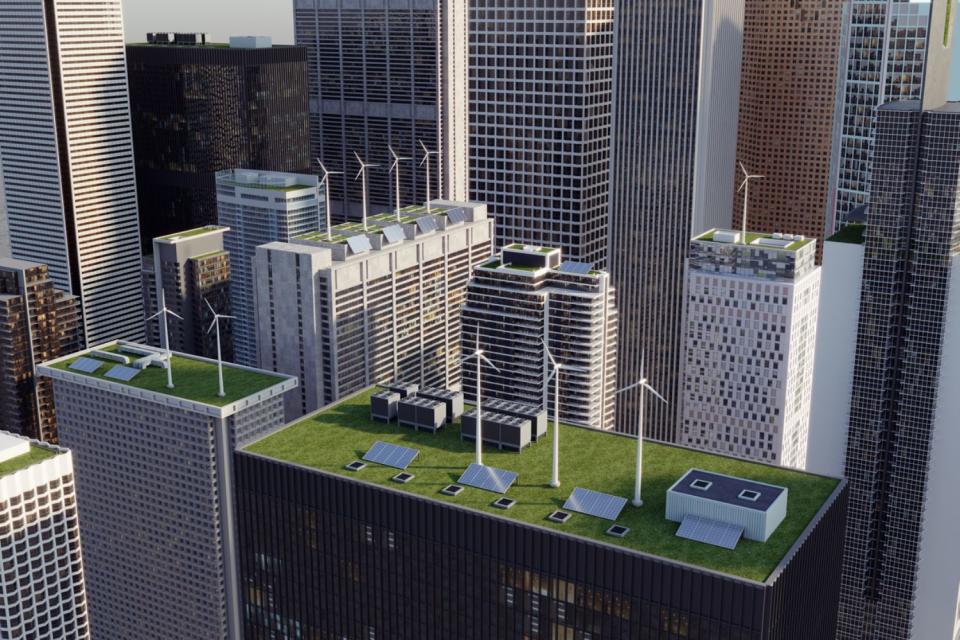
Photo: istockphoto.com
Installation Location
If the goal is to install a small wind turbine for home use, the location is critical for success. The first reason is that nearby topographical features can affect how well a turbine works. Depending on the survey or inspection results from the installation company, homeowners could have the option to make changes to the terrain, but this will add to the cost. Simpler adjustments such as clearing trees will add to the cost, but it will also improve the turbine’s performance.
One way to improve a turbine’s efficiency is to place it on higher ground to catch the wind. However, taller towers with stronger bases will likely cost more than models placed closer to the ground that require less stability. Average wind speeds can also influence material costs. Homeowners who live in areas with stronger winds will often see higher initial costs. This is because turbines must be larger or more robustly built to avoid damage.
Labor
Labor is a significant component of the home wind turbine cost. Since the cost range for a home turbine is broad, it’s challenging to pinpoint average labor costs. But several factors can influence an installation company’s labor fees, including local labor rates, current demand, and other geographic factors. Depending on the size of the turbine and the complexity of the project, the labor to install a home wind turbine averages $500 to $2,000.
Connecting the turbine to the grid or home battery storage system requires the expertise of qualified electricians or professional installers who are licensed to work on wind turbines. If a site is difficult to reach, there may be additional labor costs for transporting and setting up the turbine. And if unexpected issues crop up during the installation process, this can also result in extra labor costs.
Maintenance
Wind turbines require routine maintenance to ensure optimal performance and longevity. Maintenance tasks typically include cleaning the turbine components and inspecting for signs of wear or damage. Parts such as bearings, gears, or blades may need to be periodically replaced as the turbine ages and to reduce noise from any number of parts.
Annual wind turbine costs for maintenance depend on the size and type of wind turbine system. Small roof-mounted turbines have lower maintenance costs than large freestanding wind turbine systems, which could cost several thousand dollars per year to maintain.
Tax Credits
The Residential Clean Energy Credit offers a 30 percent tax credit on qualifying expenses related to installing and operating clean energy components on residential property. This includes solar panels, geothermal heat pumps, fuel cells, battery storage technology, and wind turbines.
These credits help offset residential wind turbine installation costs. It’s worth noting that the credit will gradually decrease to 26 percent in 2033 and 22 percent in 2034 for all turbine installations. To maximize the benefits, installing a turbine sooner rather than later can help U.S. homeowners access this tax credit for small wind turbine installation on new or existing primary residences.
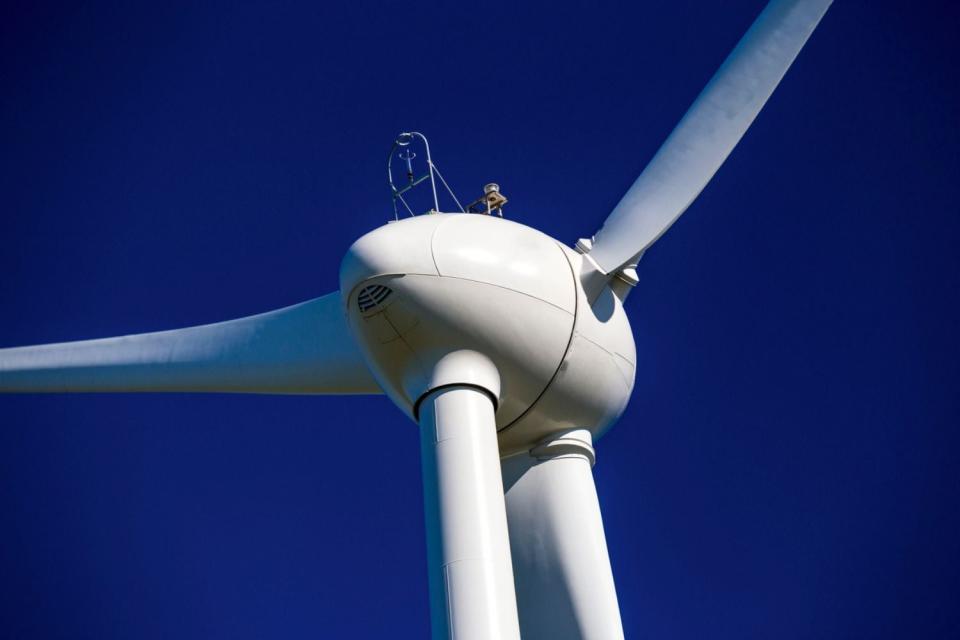
Photo: istockphoto.com
Types of Home Wind Turbines
When calculating the expected cost of a wind turbine, it’s crucial for homeowners to understand the differences between available models. The most common types—roof-mounted and freestanding—each have distinct advantages and disadvantages that homeowners can review to make an informed decision.
Roof-Mounted
As the name suggests, a roof-mounted or rooftop wind turbine is installed on the roof of a house to harness wind energy. Compared with other types, roof-mounted turbines are relatively low cost. However, they’re best for supplementing household electricity needs rather than serving as the only power source since they are smaller and generate less power.
It’s also important to know that roof-mounted turbines aren’t eligible for net metering benefits. Some utility companies will accept excess energy from solar or wind power sources and provide the homeowner a credit on their utility bill. Without the option of net metering, it may be more challenging to offset installation costs with those excess energy credits.Yet the lower installation cost may make this style appealing to homeowners who simply prefer to lower their monthly energy bill and enjoy a faster return on investment (ROI).
The average cost of a roof-mounted turbine is $3,000, though the final cost will vary based on capacity and quality of the turbine. Homeowners are encouraged to speak with an installer about the possibility of higher installation costs if structural modifications to the roof are required.
Freestanding
Freestanding wind turbines are built on the ground for a stronger support structure for the blades and generator. Typically, freestanding models offer a much higher energy output than a roof-mounted wind turbine for homes. They can power an entire house and are most suitable for areas with plenty of open space and consistent winds.
However, freestanding wind turbines have higher up-front costs, with smaller systems ranging from $50,000 to $80,000 to install. Maintenance expenses will be much higher than those for roof-mounted turbines due to their larger size and complexity. They’re also rarely allowed in densely populated areas since there may be zoning restrictions and a lack of adequate space without obstructions.
Benefits of Installing a Home Wind Turbine
While there are advantages and challenges to wind energy, installing a home wind turbine can be both eco-friendly and cost-effective for monthly energy bills. Home wind generation can be an invaluable investment for budget-conscious and environmentally minded homeowners who prefer clean energy sources to avoid producing excess carbon emissions.
Decreased Energy Bills
Homeowners may wonder why their electric bill is so high and choose to look into solutions to save on monthly costs. Sometimes, upgrading the HVAC system or addressing drafty doors and windows can be an immediate solution. But even if a homeowner makes updates to improve an old house’s energy efficiency, in some cases, a home’s occupants just use more energy.
Fortunately, homeowners can reduce their grid dependency and enjoy lower energy bills by using home wind turbine electricity. Additionally, some utility companies offer net metering programs that allow homeowners to sell excess energy back to the grid in exchange for credits on their energy bills, thus helping to absorb traditional energy costs.
Increased Home Value
Home wind turbines can boost property values and capture the attention of potential buyers for several reasons. To start, wind turbines are a unique feature that appeals to potential property owners who want renewable energy sources available to them. And apart from the environmental benefits, government incentives and tax credits make wind turbines even more appealing to buyers looking to maximize their investment. Additionally, potential home buyers are likely to consider the possible energy cost savings when deciding how much a property is worth.
For homeowners considering a wind turbine installation as part of an upgrade to boost their home’s value and selling potential, it’s worth researching the best home wind turbines to ensure a high return on investment.
Clean Energy Source
Reducing carbon emissions can have a significant positive impact on the environment. Home wind turbines are an excellent choice for clean, renewable energy. Wind power produces electricity without toxic emissions, which promotes a minimal environmental footprint, zero fuel consumption, and no air pollution or greenhouse gas emissions.
However, clean energy often comes at a cost. For homeowners interested in a clean energy source, exploring the cost of solar panels may be more budget-friendly with a faster ROI. By working with the best solar companies, such as SunPower, homeowners can enjoy a quick transition to a more sustainable energy source.
High Efficiency
Wind turbines for homes can provide better efficiency if the model selected is the appropriate size for the home’s needs. A roof-mounted unit can’t power an entire house alone, though a freestanding unit could. Ultimately, wind turbines provide efficient power, especially when combined with other renewable sources like solar panels.
Yet unlike solar panels, which might experience reduced efficiency in low-light conditions and cannot convert energy overnight, a home wind turbine system can continuously generate power if it’s positioned in an area with constant wind.
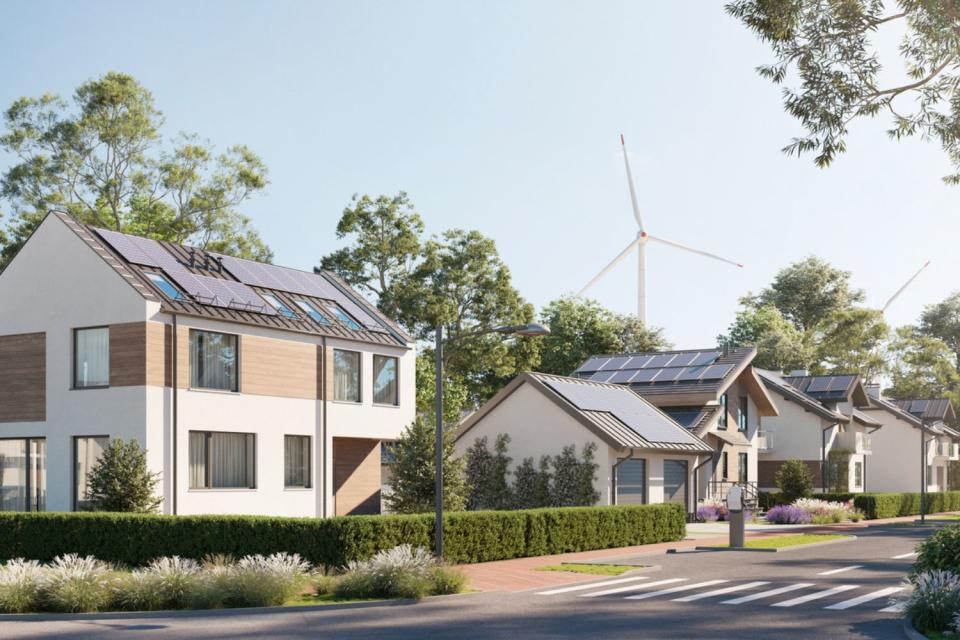
Photo: istockphoto.com
Home Wind Turbine Installation: DIY vs. Hiring a Professional
For many homeowners, choosing to install a home wind turbine involves deciding whether to tackle the project independently or bring in a professional. Opting for a DIY approach on a small roof-mounted unit offers potential cost savings and a hands-on learning experience for a homeowner who is experienced with electrical work. However, DIY installations come with inherent risks, including safety issues and the possibility of technical errors.
However, hiring a professional installer ensures a safe and federally compliant wind turbine installation. Professionals can navigate regulatory requirements and ensure the site location, unit position, and kilowatt capacity is ideal for the home’s needs. Although professional installation costs more up front, it minimizes the risk of serious mistakes.
In fact, there are plenty of questions about small wind turbines homeowners may have when determining if their property is suitable for a home wind turbine. One of the most significant benefits of working with a professional is their ability to evaluate a property for ideal wind energy production and choose the best positioning for long-term functionality. Installation and maintenance of small wind turbine systems is best done by pros who have the expertise and time to handle such projects from start to finish.
How to Save Money on Home Wind Turbine Cost
Installing a wind turbine is an investment that can pay off in the long run for homeowners. But at first, installation costs can be difficult to absorb. Homeowners have a few options to save money on home wind turbine costs.
Research and compare prices. Homeowners can research various turbine models and several installation companies (at least three) to find the most cost-effective options without sacrificing quality or professionalism.
Explore financing options. Many companies offer financing plans for renewable energy projects like wind turbines. Such options can spread out the up-front costs and make the initial investment more manageable.
Minimize energy usage. To offset initial costs, homeowners can minimize their energy usage. Unplugging appliances can save electricity, and doing so can help provide significant savings over time.
Tax credits and incentives. Homeowners can checkwith local authorities or government agencies for available tax credits, rebates, or incentives for installing a home wind turbine. This can help reduce some of the initial investment costs.
Questions to Ask About Home Wind Turbine Installation
When homeowners are searching for an installation company specializing in home wind turbines, asking the appropriate questions is essential to ensure a successful project. There are several questions to ask professionals during the vetting process.
Are you experienced in home wind turbine installation?
How many home wind turbines have you installed?
Are you licensed and insured for this type of work?
What type and size of wind turbines do you typically install?
Can you provide a list of references?
What permits will be required?
Do you recommend a wind turbine for my property?
How do you assess a home’s suitability for a wind turbine?
How do you determine the ideal location and height for a wind turbine?
How long will the installation take?
What are your payment requirements?
Do you offer financing options?
Can you provide any information on local incentives or tax credits for installing a wind turbine?
How do you handle customer concerns or complaints?
What type of ongoing maintenance will each type of turbine require?
How much will it cost to add battery storage?
Can this unit be used in addition to solar power?
What warranties do you offer?
FAQs
Home wind turbines offer economic and environmental benefits. However, absorbing the average home wind turbine cost isn’t always easy for budget-conscious homeowners. Still, a residential wind turbine can reduce monthly energy bills, boost property value, and reduce a home’s carbon footprint.
Q. How much electricity does a home wind turbine produce?
The amount of electricity a home wind turbine produces depends on various factors, including the size of the turbine and the average wind speed at the installation site. On average, small wind turbines typically produce 400 watts to 20 kilowatts per day, while larger turbines generate more electricity.
Q. Can a small wind turbine power a house?
The majority of residential wind turbines are used as supplementary power sources to reduce a household’s dependency on the energy grid and reduce energy bills. Solar and wind power are intermittent energy sources often installed together to provide a continuous power supply. Wind energy can also be stored in batteries for later use. Wind turbines can contribute significantly to a home’s energy needs, even if they aren’t the sole power source.
Q. What are the disadvantages of wind turbines?
The disadvantages of wind turbines include high initial costs, significant land requirements, dependency on consistent wind patterns, regulatory restrictions in some areas, aesthetic concerns from neighbors, relative inefficiency compared with other energy sources, and environmental impacts on migratory birds.
Another significant disadvantage of wind turbines is that they are rarely recycled due to the fiberglass material. Turbine blades can be as long as a yardstick or an airplane’s wing, so they take up significant room in a landfill when they wear out. While wind energy has its downsides, it’s still a good option for reducing carbon footprints and energy bills for those who are interested in sustainable energy sources.
Q. Is solar or wind power better?
Overall, wind energy is more efficient than solar energy since it produces no carbon dioxide while generating more power. However, wind turbines are visually unattractive, take up a lot of space, and can harm wildlife. On the other hand, solar panels are more practical for urban areas since they’re easily installed on rooftops. Both options require a consistent source of energy from the sun or wind, which means one or the other may be better suited for certain climates and geographic regions.
Sources: U.S. Department of Energy, The Roundup, Windustry, Energy Sage

